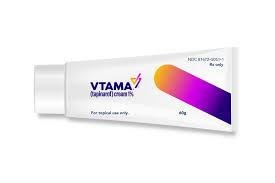Tapinarof (Topical) (Monograph)
Brand name: Vtama
Drug class: Anti-inflammatory Agents, Miscellaneous
Introduction
Aryl hydrocarbon receptor agonist.
Uses for Tapinarof (Topical)
Plaque Psoriasis
Topical treatment of plaque psoriasis in adults.
Treatment selection in psoriasis is primarily based on disease characteristics (e.g., severity, location, presence of psoriatic arthritis), with additional consideration given to patient age and comorbidities; topical psoriasis therapies are typically used alone for mild disease on limited areas of the body and adjunctively in moderate to severe disease.
Tapinarof (Topical) Dosage and Administration
Administration
Administration
For topical use only; not for oral, ophthalmic, or intravaginal use. Wash hands after application, unless cream is used for treatment of the hands.
Dosage
Adults
Plaque Psoriasis
Topical
Apply a thin layer of tapinarof 1% cream to affected areas once daily.
Each gram of the cream contains 10 mg of tapinarof.
Special Populations
Hepatic Impairment
No specific dosage recommendations at this time.
Renal Impairment
No specific dosage recommendations at this time.
Geriatric Use
No specific dosage recommendations at this time.
Cautions for Tapinarof (Topical)
Contraindications
-
None.
Warnings/Precautions
Specific Populations
Pregnancy
Available data insufficient to evaluate for a drug-associated risk when used during pregnancy.
Lactation
Not known whether tapinarof distributes into human milk, affects milk production, or affects breastfed infants. Data suggest tapinarof distributes into animal milk, therefore, likely distributes in human milk.
Pediatric Use
Safety and efficacy not established in pediatric patients <18 years of age.
Geriatric Use
In principal efficacy trials, 14.5% of patients treated with tapinarof were ≥65 years of age and 1.2% were ≥75 years of age. No overall differences in efficacy, safety, or tolerability relative to younger adult patients.
Hepatic Impairment
Effects of hepatic impairment on tapinarof pharmacokinetics not evaluated.
Renal Impairment
Effects of renal impairment on tapinarof pharmacokinetics not evaluated.
Common Adverse Effects
Common adverse reactions (≥1%): folliculitis, nasopharyngitis, contact dermatitis, headache, pruritus, influenza.
Drug Interactions
No formal drug interaction studies with tapinarof to date. In vitro, does not inhibit CYP2B6, 2C8, 2C9, 2C19, 2D6, or 3A4/5. Does not induce CYP1A2, 2B6, or 3A4. In vitro, does not inhibit P-glycoprotein (P-gp), breast cancer resistance protein (BCRP), organic anion transporter (OAT) 1, OAT3, organic cation transporter (OCT) 1, OCT2, organic anion transporting polypeptide (OATP) 1B1, OATP1B3, multidrug and toxin extrusion (MATE) 1, or MATE-2K. Not a substrate for P-gp, BCRP, OATP1B1, or OATP1B3.
Tapinarof (Topical) Pharmacokinetics
Absorption
Following repeated topical application, no accumulation observed.
Distribution
Extent
Not known if distributed into human milk.
Plasma Protein Binding
In vitro, approximately 99%.
Elimination
Metabolism
Undergoes oxidation, glucuronidation, and sulfation in the liver.
Stability
Storage
Topical
Cream
Store at 20–25°C; excursions permitted between 15–30°C. Do not freeze or expose to excessive heat.
Actions
-
An aryl hydrocarbon receptor (AhR) agonist.
-
Specific mechanism by which tapinarof exerts therapeutic effects in psoriasis not known.
Advice to Patients
-
Advise the patient to apply tapinarof cream once daily to psoriasis skin lesions only and avoid unaffected areas of skin.
-
Advise the patient to wash hands after each application unless tapinarof cream is being used for treatment of the hands.
-
Inform patients that tapinarof cream should only be applied externally.
-
Advise patients to inform their clinician of existing or contemplated concomitant therapy, including prescription and OTC drugs and dietary or herbal supplements, as well as any concomitant illnesses.
-
Advise women to inform their clinician if they are or plan to become pregnant or plan to breast-feed.
-
Inform patients of other important precautionary information.
Additional Information
The American Society of Health-System Pharmacists, Inc. represents that the information provided in the accompanying monograph was formulated with a reasonable standard of care, and in conformity with professional standards in the field. Readers are advised that decisions regarding use of drugs are complex medical decisions requiring the independent, informed decision of an appropriate health care professional, and that the information contained in the monograph is provided for informational purposes only. The manufacturer’s labeling should be consulted for more detailed information. The American Society of Health-System Pharmacists, Inc. does not endorse or recommend the use of any drug. The information contained in the monograph is not a substitute for medical care.
Preparations
Excipients in commercially available drug preparations may have clinically important effects in some individuals; consult specific product labeling for details.
Please refer to the ASHP Drug Shortages Resource Center for information on shortages of one or more of these preparations.
|
Routes |
Dosage Forms |
Strengths |
Brand Names |
Manufacturer |
|---|---|---|---|---|
|
Topical |
Cream |
1% |
Vtama |
Dermavant Sciences |
AHFS DI Essentials™. © Copyright 2024, Selected Revisions October 28, 2023. American Society of Health-System Pharmacists, Inc., 4500 East-West Highway, Suite 900, Bethesda, Maryland 20814.
Reload page with references included
More about tapinarof topical
- Compare alternatives
- Reviews (36)
- Side effects
- Dosage information
- During pregnancy
- Drug class: topical antipsoriatics
- Breastfeeding
- En español

